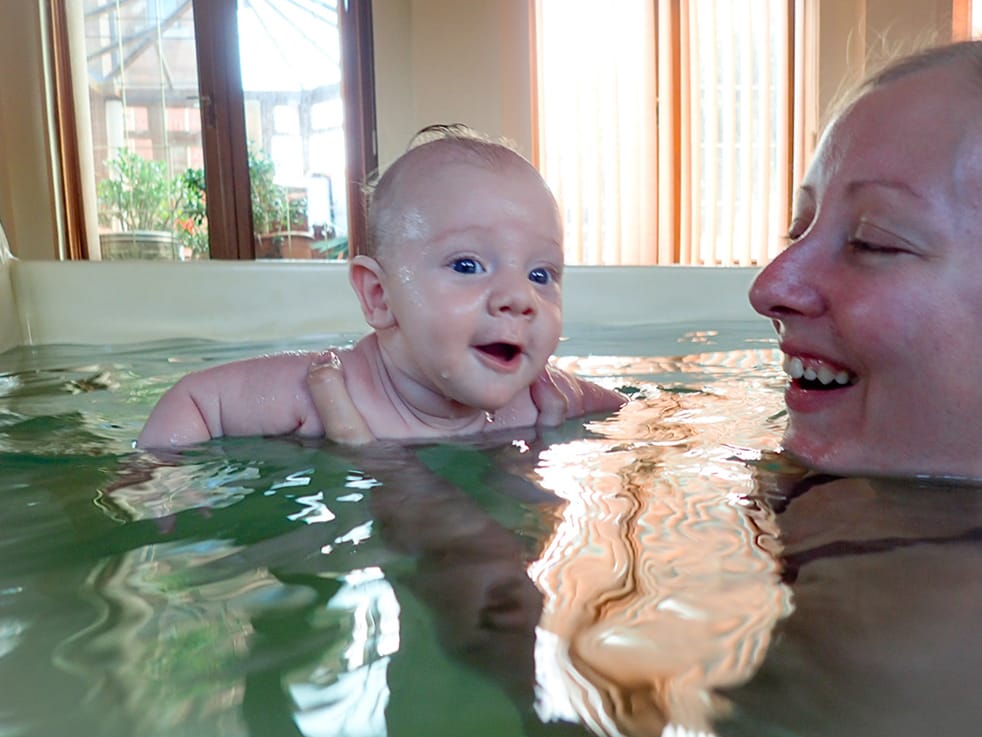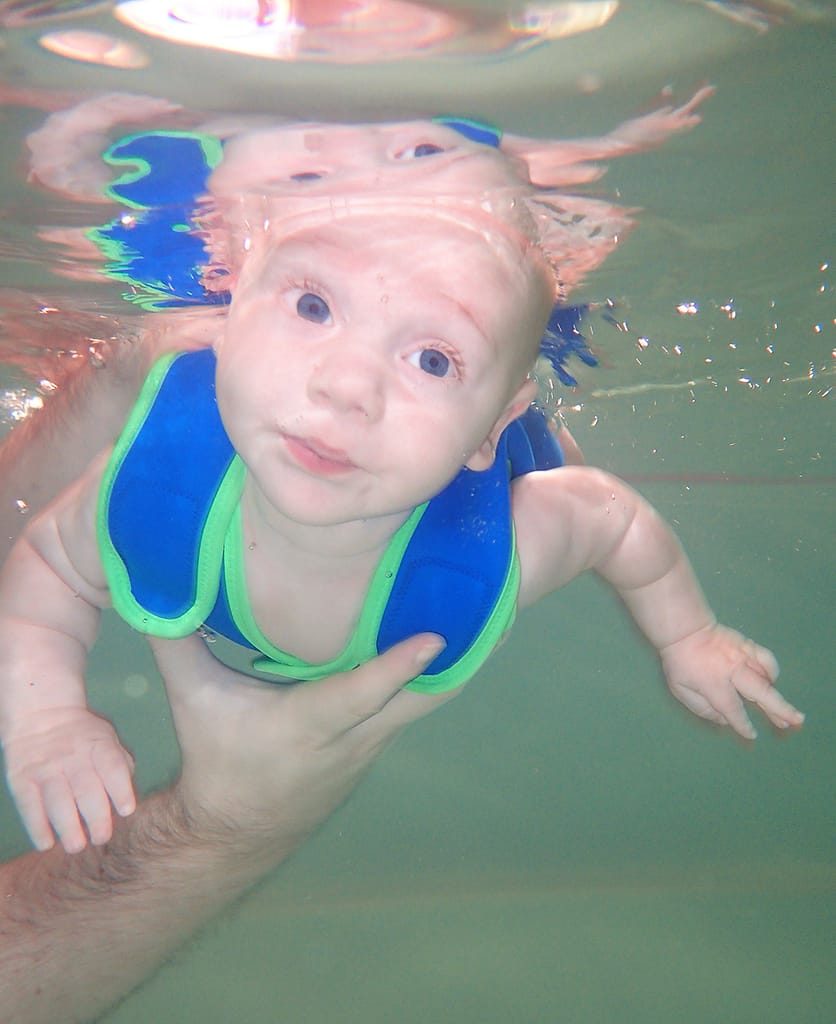Your cart is currently empty!
Teaching Your Baby to Swim
Scrap the baby swim lessons
While learning about teaching your baby to swim, please be aware that this post includes affiliate links, which means that if you purchase through those links, I may earn a commission at no additional cost to you.
Have you thought about taking your baby swimming when they arrive? Or does the thought freak you out?
Are you confident in the water? Do you love a good swim?
Is taking your little one swimming something you are excited about? Or are you a little nervous?
Teaching your baby to swim, is not always at the top of people’s list of priorities when their baby is born. They go to playgroups and baby massages but do not always swim. However, when they do take little ones swimming, it is a swim class for babies.
Thinking about taking baby swimming
If you are comfortable in the water, then there is no reason for you to take your few-month-old baby to swim lessons. Honestly, there is no need to take your child to swim lessons until they are comfortable in the water and can keep themselves afloat. Here in the UK, you get several months, if not a year maternity. There is plenty of time between naps and feeds to take your child swimming for 20-30 minutes. Most swimming pools have decent membership, and it is probably cheaper than swim lessons. It most likely comes with other benefits for you as an adult. I pay £29 a month and that allows me to swim anytime with up to four of my children, plus it allows me to use the gym facilities and any classes.

Life Skill
Swimming is something I feel is an important life skill. A child should be confident and comfortable in the water. If a child can walk or run past a body of water, they should know, to some extent, what to do if they fall in. This can save a child’s life. Remember you can take a baby swimming once their umbilical cord has detached and healed. However, it is the mother that is not able to go swimming for at least 6 weeks. This is to help prevent infection.
Luke was a national-level swimmer and I have been able to swim since I was around 2.5 years old. So, our children learning to swim is important to us.
Our Experience
When I had Nathan, I was so excited to take him swimming, and we ended up going 3-4 times a week. Even though I am a confident swimmer, I researched how best to facilitate my child’s progress in the water. When he was under 6 months, we originally had a little wetsuit, but I was not a fan, so we got a body wrap to help keep him warm and allow free movement of his arms and legs. When he was over 6 months old, we bought this float suit.
This is a suit that has individual floats around the centre. Allowing your baby to have free movement of arms and legs while learning to swim independently. One thing though, these take time to learn how to control and you must always be watching your child. Even after getting control, they can become stuck on their back or front. As our children got used to the suit, we would take them out of it for the last few minutes to help them realise that they needed to learn to float without it.
We slowly removed the floats and then eventually just did not put the suit on. Nathan has now been able to swim since he was around 2.5 years old, and honestly, I would not say that we taught him anything. We simply modelled and facilitated, and now at 6 years old, he can swim 25 meters +. We are currently doing the same with Phoenix, and he is loving the water just as much as his brother did. At just over 2 years old Phoenix has decided he no longer wants the float suit on. He now grabs the nearest pool noodle and then kicks himself off into the pool.
Helping your child to swim is a big accomplishment. You can look at your child and say, I did that. Once you are feeling comfortable taking baby swimming you need to make sure you have everything and are happy with the pool. There is no need for super warm private pools, a baby is perfectly fine going to a local pool with a temperature of 30 degrees once they are over 12lbs.
Preparation for swimming
Swim nappies
Remember that swim nappies DO NOT hold urine. So, DO NOT put them on your child until you are getting ready at the pool. Also, though they do hold poo, try to go between poos.
Swimsuit
For us, we had a baby wrap wetsuit over the top of a swim nappy. It worked perfectly. Importantly, don’t forget your swimsuit.
Towel
You will need towels for both you and your baby. Some people take two for their baby. One to wrap them in straight from the pool (have it on poolside) and one to dry them off to get dressed.
Lock or Money
This is for the locker if you want to use them. Some pools have space to leave a bag poolside, but it’s always better to have a backup.
Now you know what you need to take with you, it is time to prepare for how you can help your child learn to swim. The number one thing to remember is safety is of the utmost importance.
Teaching your baby to swim
Start early
Baby can go swimming as soon as you are ready to take them. Though remember that your baby should be 12 lbs, for the water to be ok at 30 degrees. The earlier you take your baby swimming the quicker they become comfortable and confident they will be in the water.
Floating
When teaching your baby to swim, do not worry about using flotation devices with a young baby, you are all they need. You can lay them on their back with your hand under their head/neck and bottom, allowing your baby to kick their legs and move their arms. Learning to float on their back is an important skill as this could save their lives in the event they fall into the water. You can also have them float on their belly, once they can hold their head up, with your hands under their arms.
Rolling over
Another important skill is for your baby to know how to roll from front to back or back to front. This can help if they find themselves in danger. You can teach rolling by holding them on their front and gently rolling them and getting them to relax. You could even give them a cue every time you do this.
Cueing
It is good to let your child know if you are going to splash water on them or duck them underwater for a short time. You can do this by counting down or using ready, steady, and go.
Dunking

This can be a difficult thing for parents to do with their children. However, when done correctly it can greatly improve your baby’s confidence in the water. As long as they are enjoying it. Do not force it if your child gets distressed. With my children I held them out in front of me, facing me, and talked to them. I would then count down from 3 and blow in their face. Once they took that breath, I would dunk them underwater and bring them towards me. I would be smiling when they came up and brushed the water from their face, always showing how fun that was.
Kicking
A child needs to learn to kick their legs in the water. This is how they will mostly move through the water after all. You can do this by holding them under their arms and propelling them through the water. Remember to comment on their kicking with smiles.
Conclusion
When teaching your baby to swim, have fun and relax. Do not worry about how fast your child is learning, just watch their confidence grow. Follow their lead and enjoy the bonding happening between you and your baby. Remember as they get older and have some independence, model the behaviour you are teaching. An example would be going underwater and coming out smiling. This can help them learn that these things can be ok. Good Luck and have fun.
Comments
2 responses to “Teaching Your Baby to Swim”
-
Hello there, You have done an excellent job. I will definitely digg it and personally suggest to my friends. I am sure they’ll be benefited from this website.
-
Thank you for your comment.
-

Leave a Reply